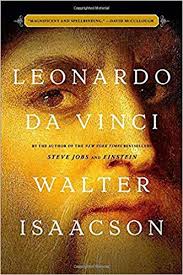Leonardo da Vinci by Walter Isaacson

Life and Career
Leonardo da Vinci was born out of wedlock in 1452 in the Republic of Florence to a notary father and a peasant mother. His illegitimate birth made him ineligible to join the local notary guild and become a notary like his father. At 14, after receiving an informal primary-grade education, he became an apprentice of Andrea del Verrocchio, a painter and sculptor in Florence. Leonardo became an independent master painter in his 20s, but his low output and excessive procrastination was detrimental to his career.
In 1482, Florence’s de facto ruling family sent Leonardo as part of a delegation to Milan. Leonardo wrote Milan’s ruler, Ludovico Sforza, a job letter in which be boasted of his skill as a military engineer (he had never done any work of the sort) and mentioned as an afterthought that he could also paint. Leonardo stayed in Milan for the next 18 years. While he never got to do any military engineering for Sforza’s government, he received work as a painter, sculptor, architect, and organizer of public entertainment.
When Milan was invaded by France in 1499, the new French government was impressed by Leonardo’s artwork, but Leonardo returned to Florence and established an art studio there. He finally fulfilled his fantasy of being a military engineer when he briefly worked for the warlord Cesare Borgia, but Borgia’s brutality left him disillusioned.
Between 1506 and 1516, Leonardo drifted between Milan, Florence, and Rome, largely disillusioned with painting and deeply immersed in his scientific studies. After searching in vain for a patron who didn’t just view him as a master artist but also appreciated the full breadth of his skills, he finally got the attention of King Francis I of France. Francis I invited Leonardo to France to work as his personal “painter, architect, and engineer” and gave him a house in Amboise. Leonardo lived in France until his death in 1519 at the age of 67.
Art
Leonardo was recognized in his lifetime primarily for his paintings. Leonardo was a groundbreaking painter thanks to his deep understanding of light and optics, his keen powers of observation, his studies into other disciplines, and his obsessive perfectionism. His paintings are notable for their accurate lighting and shading, their realistic portrayals of depth and distance, their faithful anatomical and geological accuracy, their accurate portrayals of objects in motion, and their captivating emotional narratives.
Notebooks
An insatiably curious man, Leonardo independently studied many subjects that were outside his primary education as a painter. His interests included optics, anatomy, architecture, machinery, geology, hydrology, powered flight, geometry, and civil engineering. He first learned about many of these subjects to help improve his art, but he usually got deeply immersed in them and started studying them for their own sake.
Thousands of pages of Leonardo’s personal notes have been found. His notes are full of drawings and text written in right-to-left mirror-script. They are often arranged in a disorderly fashion with lots of subjects being discussed on the same page. Leonardo frequently expressed his intention to write treatises on topics he had studied, but he rarely wrote anything orderly enough to be published and never published any texts in his lifetime. In various fields, he made findings that were hundreds of years ahead of his time and wouldn’t be rediscovered again until centuries later. However, since he never published his works, his influence on the history of science was minimal.
Personal Character
In contrast to the stereotype of the reclusive and tormented artist, Leonardo was handsome, charismatic, and sociable. He headed a large entourage of assistants and apprentices throughout his career. He grew distant from his biological family and was eventually left out of his father’s will. With no children of his own, Leonardo gave most of his estate away to Francesco Melzi, one of his apprentices.
Having not received a classical education, Leonardo learned mostly from experience. He was a sharp observer and a voracious reader. He was skilled at making visualizations, reasoning through analogies, and making connections across disciplines. He was often feverishly obsessive about topics that interested him. More interested in conceptualization than execution, he had a tendency to abandon many of his projects partway through. He did not care much about money or fame unless they were very scarce. Though he lived in a pre-scientific world, his level of scientific rigor was impressive for his time.
